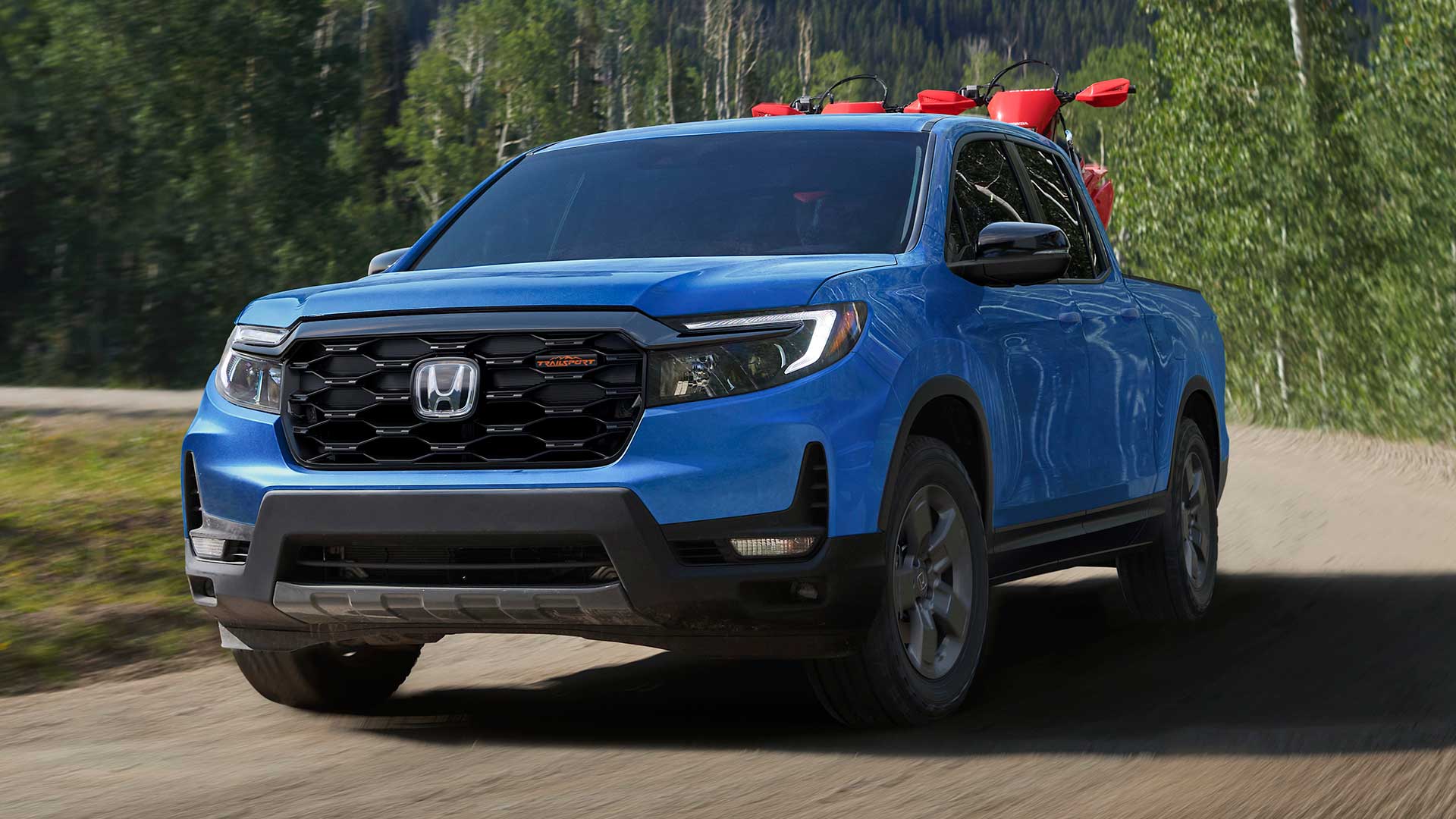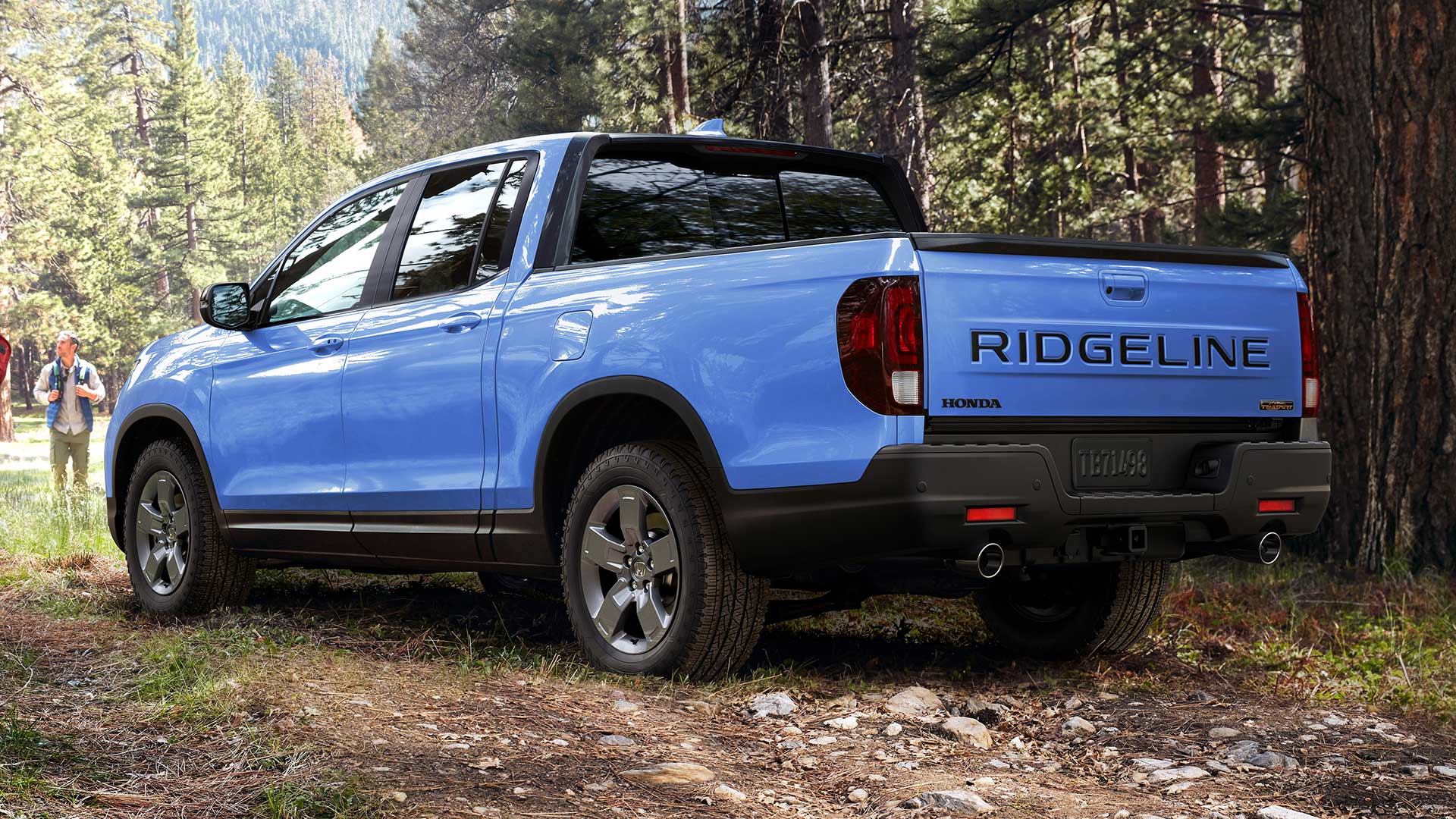2014 Toyota Tundra
When the Tundra replaced the T100 in the Toyota lineup for 2000, it was proof that Toyota was serious about taking on the domestics in the full-size pickup truck market. And while sales have never really challenged F150 or Silverado, the Tundra has carved quite a niche for itself among personal use buyers. Now let’s see if a new manly makeover will help them carve out even more sales.
It’s hard to ignore the 2014 Toyota Tundra’s changed face. It’s larger and more in your face, and in tune with the more rugged appearance that graces the rest of the truck. And that more macho design was by design.
Despite being just as capable as domestic light-duty pickups, the Tundra has thus far been unable to shed its soft image. Well, as truck current marketing-think goes; the bigger the grille, the more capable the truck! So the new Tundra’s cow catcher grows in size, yet still blends in nicely with a new 3-piece front bumper.
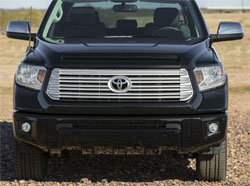 The stance is certainly wider, and fenders are a little more squared off, all helping to reaffirm this Tundra’s credentials, as does towing up to 10,400-pounds. The rear end is “branded” with Tundra script; an integrated tailgate spoiler, and a 3-piece bumper of its own, while aero tricks on the rear tail light lenses and side mirrors help this brutish brick get through the air as efficiently as possible.
The stance is certainly wider, and fenders are a little more squared off, all helping to reaffirm this Tundra’s credentials, as does towing up to 10,400-pounds. The rear end is “branded” with Tundra script; an integrated tailgate spoiler, and a 3-piece bumper of its own, while aero tricks on the rear tail light lenses and side mirrors help this brutish brick get through the air as efficiently as possible.
To keep pace with the high dollar pickups now in vogue, Toyota adds a new 1794 model that pegs the bling-o-meter with 20-inch alloy wheels and a power moon roof. 3-Cabs are available; the 2-door Regular cab and a pair of 4-doors – the extended Double cab, and the CrewMax crew cab with a standard power sliding back window. All Tundras add Halogen reflector beam headlights with manual level control; and the 1794 edition adds LED daytime running lights.
We are disappointed to see no major powertrains changes, however. It’s not that they’re inadequate. But, domestic full-size pickups, along with Nissan’s Titan, are making some serious strides in mixing more power with more fuel economy and Toyota is at risk of getting left behind.
As before, a 4.0-liter V6 is the base engine, and a pair of V8’s are available. We spent most of our time in the volume leading 5.7-liter V8 rated at 381-horsepower, and 401 lb-ft. of torque. While it pulls strongly and has a very responsive throttle, compared to domestic V8’s it tends to sound like it’s working much too hard.
It’s paired with a 6-speed automatic transmission with tow/haul mode, and gets Government Fuel Economy Ratings of 13-City, 17-Highway, and 15-Combined for our 4-wheel-drive tester. That makes for a very poor Energy Impact Score thanks to 22.0-barrels of annual oil consumption and yearly CO2 emissions of 10.0-tons.
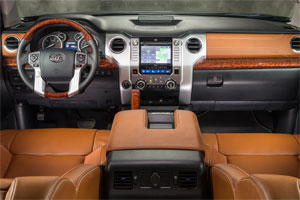 While the exterior has undeniably taken the macho route, the interior has actually gotten even friendlier. Materials vary greatly with trim level, but our CrewMax Limited had very comfortable leather clad seats and wood-style trim. Also, Tundra is the only truck with available blind-spot monitoring and rear cross traffic alert. CrewMax models offer plenty of room in the rear seats as well, whether left in place for seating, or folded up out of the way for cargo. Switchgear is nice and big, with a fairly logical layout; and major controls are closer to the driver than before for ease of use.
While the exterior has undeniably taken the macho route, the interior has actually gotten even friendlier. Materials vary greatly with trim level, but our CrewMax Limited had very comfortable leather clad seats and wood-style trim. Also, Tundra is the only truck with available blind-spot monitoring and rear cross traffic alert. CrewMax models offer plenty of room in the rear seats as well, whether left in place for seating, or folded up out of the way for cargo. Switchgear is nice and big, with a fairly logical layout; and major controls are closer to the driver than before for ease of use.
One complaint; like most rivals the Tundra’s navigation screen is hard to read in direct sunlight. The Tundra’s frame also carries over from last year, but the suspension has been revised and an improvement is quickly noticed. Ride quality is smoother and you really feel like you’re riding high and breathing thin air. Steering remains hydraulic, providing good overall feel, with better straight line stability.
 During our limited off pavement time we found the Tundra to be plenty capable of handling the less traveled way to your favorite camp site or hunting spot; and engaging 4-wheel-drive on the fly was quick and smooth. An automatic limited-slip differential is standard.
During our limited off pavement time we found the Tundra to be plenty capable of handling the less traveled way to your favorite camp site or hunting spot; and engaging 4-wheel-drive on the fly was quick and smooth. An automatic limited-slip differential is standard.
And when it comes to pricing, starting at just $26,915 the Toyota Tundra is a lot of truck for the money. The 2014 Toyota Tundra has improved greatly and without a doubt has proved itself to be a viable alternative to the Big-3. Still, in this full-size arena, the domestics do it better. However, while Ford, Chevrolet, and RAM may not be worried at the moment; the Tundra is here to stay, and it’s getting better all the time.
Specifications
- Engine: 5.7-liter V8
- Horsepower: 381
- Torque: 401 lb-ft.
- EPA: 13 mpg city/ 17 mpg highway
- Energy Impact: 22.0 barrels of oil/yr
- CO2 Emissions: 10.0 tons/yr
2024 Honda Ridgeline TrailSport
It Does Truck-Like Things Better Than Ever
Honda brought something truly unique to the pickup truck scene when their mid-size Ridgeline debuted for 2006. In 2017, it moved towards becoming a little more true truck-like, both in form and capability, now with yet another step in that direction for 2024. So, let’s see if the Ridgeline is really hitting its stride.
For 2024, it’s all about making this Honda Ridgeline better than ever. There are styling tweaks outside, along with tech and functional improvements inside, but the biggest news is the Ridgeline has now joined Honda’s TrailSport family of off-road inspired vehicles. This more-true-trucklike, second-gen Ridgeline been around since 2017, receiving periodic updates over the years; but joining the TrailSport family is the biggest leap yet.
Primarily, the TrailSport transformation includes General Grabber all-terrain tires, mounted on new Pewter Gray 18-inch wheels, steel underbody protection, and retuning the strut front, and multi-link rear suspension for added wheel articulation. And while we always appreciate the additional traction of off-road tires, the Ridgeline’s standard i-VTM4 all-wheel drive, with Intelligent Traction Management and snow, sand, and mud settings, was already quite capable of handling all but the most extreme off-roading, ground clearance of just 7.6 inches being it’s only real hinderance.
A 3.5-liter V6 remains under the hood as it has since the Ridgeline debuted for 2006; the current version outputs 280 horsepower and 262 lb-ft of torque, plenty enough muscle to handle its 5,000-lbs. towing capacity. A nine-speed automatic transmission with paddle shifters and bevy of push and pull buttons on the console replaced the six-speed automatic back in 2020.
In addition to adding TrailSport capability, a big focus for this update was making it more user-friendly inside, starting with the central touchscreen growing from 8 to 9 inches. It also gets faster processing speeds, menus have been simplified, and the native navigation system is improved with better graphics. It’s accompanied by a new digital instrument cluster, along with an upgraded center console with more storage space. Unique TrailSport touches include heavy duty floormats, leather-trimmed seats, orange stitching throughout the cabin, and orange ambient lighting.
The Ridgeline continues to offer things available nowhere else in the pickup truck market.
Exterior styling doesn’t exactly shout “macho big rig coming your way,” but the more vertical face and larger grille that arrived for 2021, along with this year’s added TrailSport elements, do continue to toughen up the Ridgeline’s image. The 5’4” bed remains highly functional with no large wheel well intrusions, multiple tie-downs points, lighting and even speakers. And of course, the Ridgeline continues to offer things available nowhere else in the pickup truck market, like the dual-action tailgate, and large, lockable, drainable, underbed storage. Not to mention being able to drive around in true car-like comfort, something we took full advantage of on our way to our Mason Dixon Dragway test track.
There was great grip off the line, with full power arriving smoothly but quickly, helping us to get to 60 in 7.0 seconds flat, a tenth quicker than the last Ridgeline we tested. That power delivery stayed fairly consistent the whole way down the track, barely interrupted by the nine-speed automatic’s smooth shifting. Our best quarter-mile run was 15.5 seconds at 90 mph.
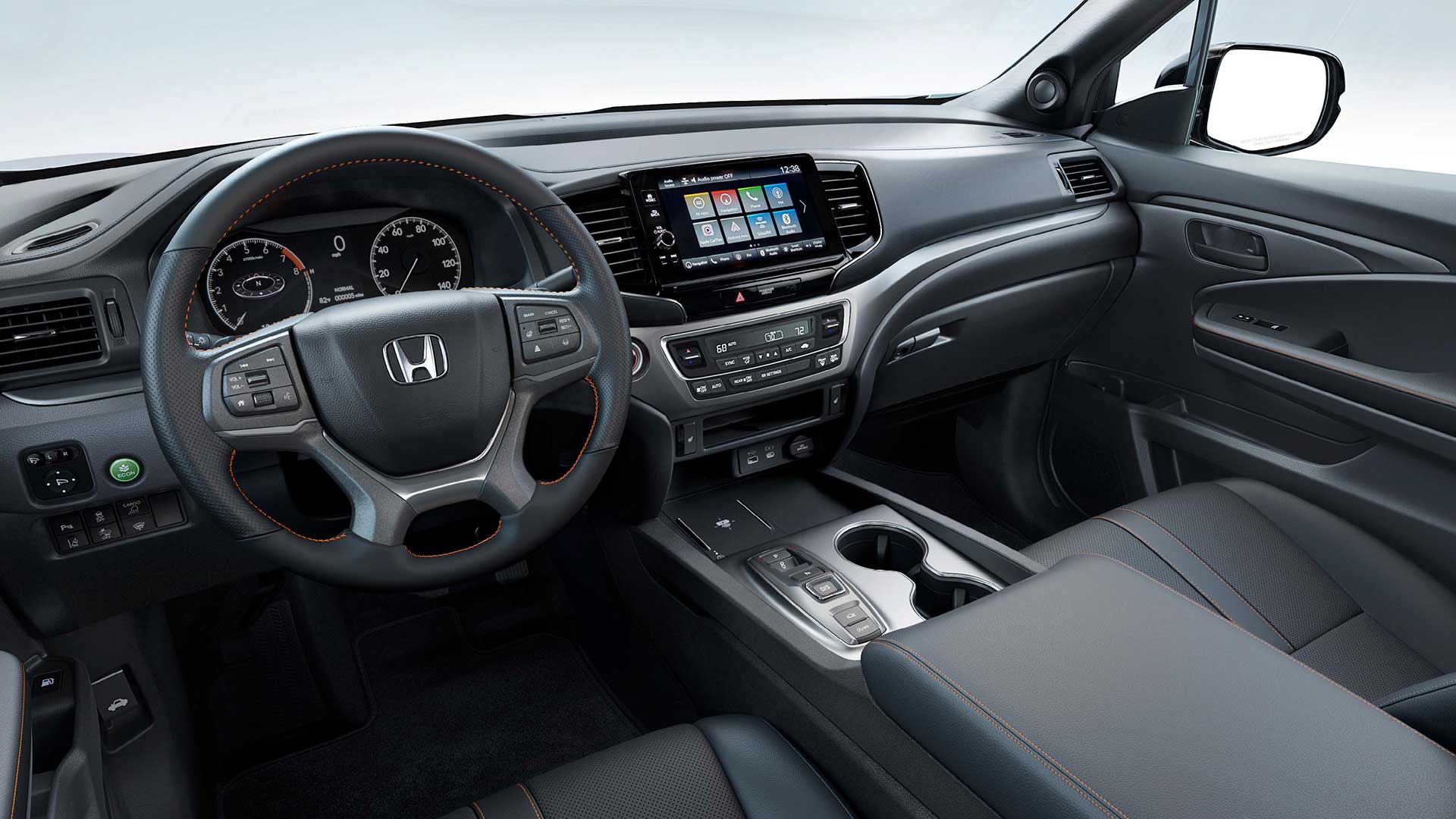
The revised suspension and knobbier tires didn’t really seem to add or detract from handling prowess, as it felt as solid, nimble, and car-like as it always has through our cone course. Perhaps a little less stiff than before, but good feedback, tight steering, and minimal body roll for a pickup, made for a very confidence inspiring experience. In our braking test, we stopped in a respectable average of 123 feet from 60, with only moderate amounts of nosedive and good feel through the pedal.
There is, however, a slight reduction in Government Fuel Economy Ratings with the all-terrain tires; 18-City, 23-Highway, and 20-Combined, our average, right on, at 20.4 mpg of Regular. That’s a slightly below average Energy Impact Score of 14.9 barrels of yearly oil use, with CO2 emissions of 7.4 tons.
TrailSport pricing falls in line just under the Ridgeline’s top Black Edition trim with a starting price of $46,375, about five grand over a base Ridgeline Sport.
So, whether you consider the Honda Ridgeline to be a “real” truck or not, this ruggedly smooth 2024 TrailSport does truck-like things better than ever. And we’re not just talking about the slight upgrade in off-road performance, we’re talking about a flexible bed to help you get chores done, and the ability to tow or haul with comfort and flexibility other trucks can only wish for. It’s why the Ridgeline brings more first-time buyers to Honda than any other vehicle, and why it continues to be a great choice in the growing midsize truck realm.
Specifications
- Engine: 3.5-liter V6
- Transmission: 9-speed automatic
- Horsepower: 280
- Torque: 262 lb-ft
- EPA: 18 City | 23 Highway | 20 Combined
- 0-60 mph: 7.0 seconds
- 1/4 Mile: 15.5 seconds at 90 mph
- 60-0 Braking (avg): 123 feet
- MW Fuel Economy: 20.4 mpg (Regular)
- Max Towing Capacity: 5,000-lbs








